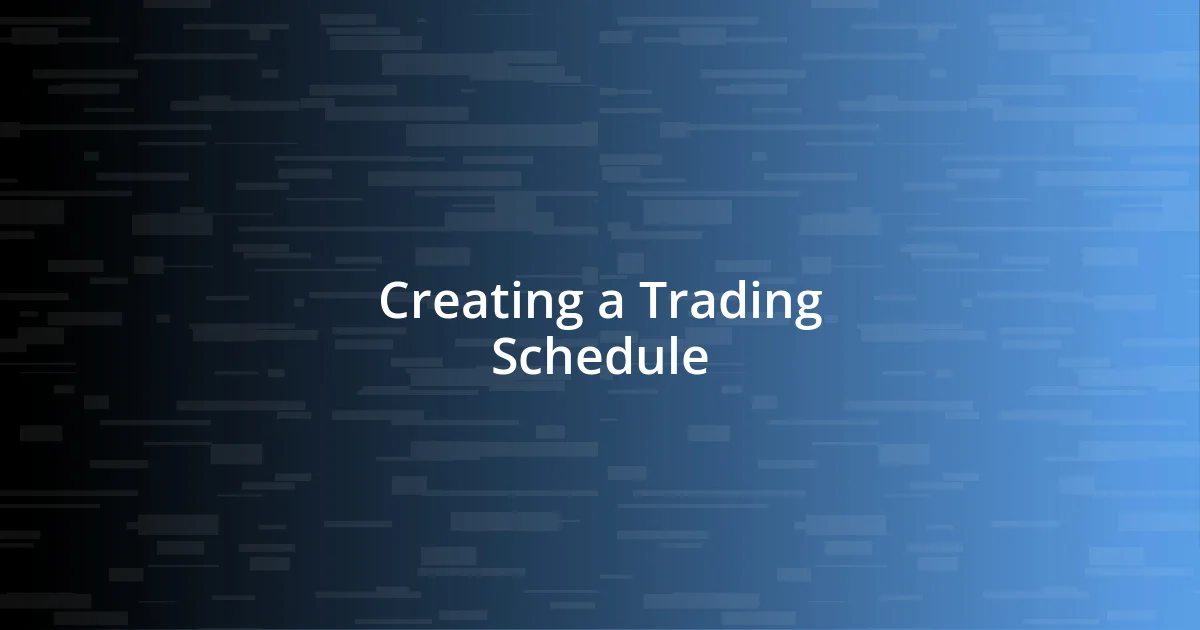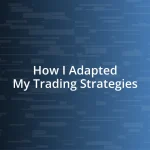Key takeaways:
- Establishing clear trading hours and setting boundaries helps balance trading responsibilities with personal life commitments, enhancing overall well-being.
- Implementing effective time management techniques, such as the Pomodoro Technique and task blocking, improves focus, reduces mistakes, and increases productivity.
- Regular self-evaluation and adjusting priorities are crucial for maintaining a healthy balance between trading achievements and personal relationships.

Understanding Trading Life Balance
Finding a balance between trading and life is like walking a tightrope. I remember a time when I spent every waking hour glued to my screen, driven by the thrill of the next trade. It wasn’t long before I realized that while profits felt good, the constant pressure took a toll on my relationships and well-being.
Have you ever felt the weight of a market downturn affecting your mood? I certainly have. Those moments made me understand that emotional resilience is vital. I had to learn that detaching my sense of self-worth from trading outcomes was essential for maintaining a healthy perspective on life.
Creating boundaries is another key aspect that I’ve explored. By setting specific trading hours, I began carving out time for family and hobbies, allowing for a richer, more fulfilling life outside trading. It’s amazing how re-engaging with my passions revitalized my trading mindset, showcasing that a well-rounded life can actually enhance my overall performance in the market.

Prioritizing Daily Responsibilities
Prioritizing daily responsibilities is crucial for maintaining a balanced life while trading. I’ve learned that managing my time effectively gives me the clarity I need both in and out of the market. There have been days when I felt the pressure to monitor trades constantly, but not addressing family commitments left me feeling quite guilty. I’ve come to understand that disregarding my responsibilities isn’t just a missed opportunity for connection; it can also affect my focus and decision-making as a trader.
To help me stay on track, I developed a simple yet effective system for prioritizing daily responsibilities:
- Set clear trading hours: I block out specific times for trading, ensuring I don’t overlap with family time.
- Create a to-do list: Each morning, I jot down both trading and personal tasks, helping me visualize and balance my day.
- Eliminate distractions: I put my phone on silent during family meals or important conversations, keeping my trading thoughts at bay.
- Practice self-care: I schedule regular breaks for exercise, allowing me to recharge both mentally and physically, which ultimately benefits my trading strategy.
By consciously prioritizing my daily responsibilities, I’ve found a rhythm that allows me to thrive in both my personal life and trading pursuits.

Creating a Trading Schedule
Creating a trading schedule is a game-changer for achieving balance in my life. I remember when I first started trading; it was all about the thrill of the chase. Yet, I quickly realized that without clear trading hours, I was simply spinning my wheels. To find my groove, I created a schedule that allowed me to trade for a couple of hours in the morning before diving into other responsibilities. That fixed time created a sense of routine, which in turn improved my focus and decision-making.
In my experience, establishing a schedule helps me avoid impulse trading. When I know I have dedicated trading times—say from 9 AM to 11 AM—I can focus solely on making informed decisions instead of getting sidetracked throughout the day. I’ve also noticed how my mood stabilizes when I adhere to this schedule. Some days, if I took even an extra hour, I’d find myself restless and distracted during family time, which doesn’t serve either my personal life or my trading.
Another aspect I’ve incorporated is flexible time slots for reviewing trades and the market. I designate an hour in the evening to reflect on the day’s decisions and learn from them. That’s a key part of my growth as a trader. The quiet moments spent analyzing trades not only boost my trading skills but also provide a sense of accomplishment at the end of the day. Balancing this reflection with family time reinforces my commitment to both trading and my personal life.
| Aspect | Details |
|---|---|
| Trading Hours | 9 AM – 11 AM with flexibility for review |
| Impact on Mood | Structured hours lead to less stress and better focus |

Implementing Time Management Techniques
Effective time management techniques have been instrumental in my journey as a trader. One of my breakthroughs was adopting the Pomodoro Technique. It’s simple: I work for 25 minutes, then take a 5-minute break. I remember the first day I tried it; I was surprised at how much I accomplished! By breaking my trading tasks into manageable chunks, I found that I made fewer mistakes and felt more energized. Have you ever found yourself staring at the charts, feeling like time was slipping away? I certainly have, but these short bursts of focused work drastically improved my productivity.
Another technique I swear by is blocking time for specific tasks. Initially, I’d haphazardly jump from one task to another, often leading to chaos in both my trading and personal life. Now, I dedicate certain blocks of time solely to analyzing trades or checking news updates. It’s a game changer—there’s something satisfying about knowing that when that block starts, it’s all about the charts. I vividly recall a day spent strictly in my trading block; I identified a pattern that led to a successful trade. That moment reinforced my belief in the effectiveness of this approach.
Lastly, I highly recommend setting boundaries around your trading activities. In my experience, my family often needed assurance that I wouldn’t be distracted during our time together. One evening, I turned off my trading notifications and committed to being fully present. The relief on their faces reminded me that life outside trading brings its own rewards. Have you considered how your time-blocking could enhance both your trading and personal relationships? It’s a powerful realization that having set boundaries allows me to enjoy both worlds without feeling torn between them.

Setting Realistic Trading Goals
Setting realistic trading goals is crucial for maintaining focus and motivation. I recall when I set an ambitious goal to double my trading capital in just a month. While it sounded exhilarating, the stress that followed was overwhelming. That experience taught me that goals should stretch me but remain achievable. Now, I aim for consistent percentage gains over a longer period, and it feels much more rewarding and sustainable.
When formulating goals, I believe it’s vital to incorporate flexibility. Life is unpredictable, and there are days when personal commitments demand my attention. For instance, there was a week when family obligations left barely any time for trading, but I had set a rigid target. The pressure I felt was unnecessary, and it detracted from my overall enjoyment of trading. Hence, I now set quarterly goals instead of monthly ones, allowing me to adapt my approach based on life’s ebb and flow.
Lastly, I always remind myself to track and celebrate small wins. It’s easy to get fixated on the big picture, but I find that recognizing incremental progress can reinvigorate my enthusiasm. Just the other day, I made a trade that wasn’t huge in profits, but the strategy behind it was sound. Reflecting on that moment brought a sense of accomplishment that fueled my motivation. Have you ever paused to appreciate your small successes? Those little victories can be the fuel that keeps our passion for trading alive, bridging the gap between aspirations and reality.

Incorporating Self-Care Practices
Incorporating self-care practices into my trading routine has been a game-changer for me. I remember the days when I was glued to my screens for hours, neglecting my physical and mental well-being. It was during a particularly stressful period that I decided to take up yoga in the mornings. Those quiet sessions not only centered my mind but also fostered a new clarity before diving into the trading day. How often do we forget to check in with ourselves when we’re consumed by numbers and charts? I realized then that a few moments of self-care could set the tone for a more productive day.
I’ve also found that nature has an undeniable healing effect. Every Saturday, I make it a point to hike in nearby trails. The fresh air and natural beauty offer a refreshing contrast to the digital world. There was a day when I almost skipped it, thinking I should stay home and analyze charts. But I pushed myself to go, and surprisingly, that outing helped me return home with a renewed perspective and sharper focus. Have you ever felt that disconnect when you spend too much time indoors? Nature has a way of grounding us if we just allow ourselves to step outside.
Finally, I encourage everyone to prioritize mental health by incorporating a gratitude practice. At the end of each day, I jot down three things I’m thankful for in my trading journey. Some entries reflect on successful trades, while others acknowledge small growth moments or lessons learned—like the time I realized it’s okay to walk away from a trade that doesn’t feel right. This simple act of reflection nurtures a positive mindset, reminding me that trading is just one part of my life. How often do you take a moment to celebrate your journey, not just the outcomes? It’s those moments of gratitude that truly amplify our connection to trading and life itself.

Evaluating and Adjusting Your Balance
Evaluating my balance between trading and life has been a continual process. I’ve learned that regular self-assessment is key to staying on track. For instance, I started keeping a weekly journal focused on my trading performance and personal life. Reflecting on that journal has revealed patterns I didn’t initially notice—like how a particularly busy week in my personal life often led to poorer trading decisions. Has that ever happened to you? Recognizing these trends allows me to adjust my approach proactively.
Adjusting my priorities is equally important. There was a period when I was so engrossed in trading that I began to miss important family events. It wasn’t until my child’s birthday passed without my presence that I realized I needed a major shift. Now, I schedule my trading around those key moments, creating boundaries that ensure I don’t lose sight of what truly matters. Have you considered what milestones in your life you might be jeopardizing? These adjustments not only enhance my relationships but also bring a refreshing clarity to my trading mindset.
Lastly, I believe it’s essential to embrace change without fear. The other day, I faced a market downturn that tested my resolve. Instead of panicking, I took a step back and evaluated my overall strategy. I recognized it was time to adjust my trading style to align with my current life circumstances—making it less about chasing profits and more about preserving my capital and well-being. This experience made me wonder: Are you open to changing your approach when life throws you a curveball? Accepting that flexibility can lead to both personal and trading growth has been a valuable lesson for me.














